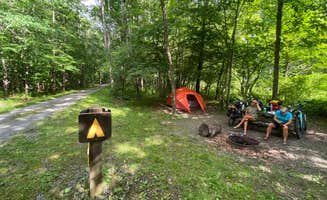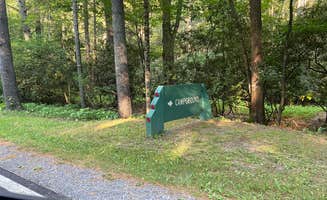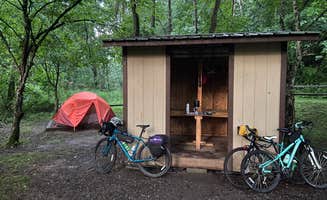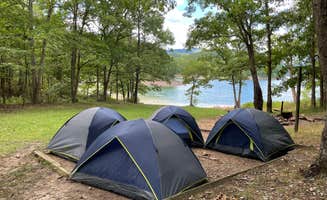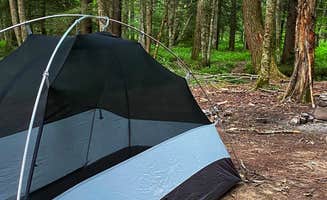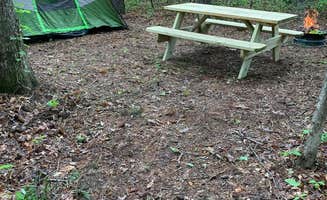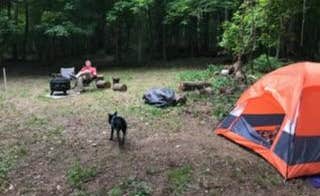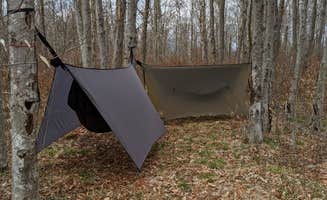The Monongahela National Forest surrounding Marlinton, West Virginia sits at elevations between 1,000 and 4,000 feet, creating distinct microclimates that affect camping conditions throughout the year. Spring runoff from higher elevations creates seasonal high water levels along the Greenbrier River and its tributaries from March through May. Summer temperatures in the valley typically reach 75-85°F during the day while dropping into the 50s at night, even during July and August.
What to do
Bicycle the Greenbrier River Trail: The 78-mile rail trail passes directly through Marlinton with numerous access points for day trips. The trail maintains a gentle 1% grade making it suitable for casual cyclists. A reviewer noted about Greenbrier River Trail MP 69.6: "The Greenbrier River Trail is a delightful bikepacking excursion. Very doable for all ages. I'd recommend road bicycles with tires no narrower than 700x32 or mountain bikes."
Wildlife viewing at dawn/dusk: The forest edges near campsites provide excellent wildlife observation opportunities, particularly along riverbanks. Visitors report consistent sightings of deer, rabbits, and various birds with occasional fox and bobcat encounters. "The amount of wildlife we saw throughout the day was incredible while biking the trail. Mostly deer, rabbit, chipmunks and Eastern Box Turtles sharing the trail...but we did see a few turkey, fox and bobcat," according to a camper at Greenbrier River Trail MP 69.6.
Visit Green Bank Observatory: Located approximately 30 minutes from Marlinton, this scientific facility offers tours of the world's largest fully steerable radio telescope. The surrounding area is designated as a National Radio Quiet Zone, creating unique camping conditions with minimal electronic interference. A reviewer at Meadow Creek Camping Area emphasized: "There are very few places in the Eastern United States that get dark enough to view the Milky Way."
What campers like
Accessible primitive camping: Most tent sites along the Greenbrier River Trail feature basic amenities while maintaining a wilderness feel. At Greenbrier River Trail Milepost 63.8 Primitive Campsite, a camper reported: "Free camping(First come, first served), Newer Adirondock Style Shelter, Newer Large/Clean/Stocked Pit Latrine, Raised Tent pad(pea gravel), Cold well water- Hand pump, Metal Fire Ring."
River access for swimming: Summer temperatures make the Greenbrier River a popular cooling-off spot for tent campers. Multiple sites offer direct river access with gradual entry points suitable for families. One reviewer observed about Poor Farm Dispersed Recreation Area: "Really enjoyed this place. Maybe 5-10 min off of highway 220. There are maybe 5 ish spots to camp next to a river in this mountain valley."
Stargazing conditions: The minimal light pollution creates exceptional night sky viewing throughout the region. Campers frequently mention setting up tents specifically to maximize nighttime star observations. "If you're in the Monongahela area and you've never seen it before, definitely head up to Spruce Knob on a clear night. You won't be disappointed," wrote a visitor to Meadow Creek Camping Area.
What you should know
Limited cell service: Most camping areas around Marlinton have no cellular coverage. A camper at Day Run Campground advised: "Nice size sites for tents and/or RV. All come with Lantern pole, fire ring with grate for cooking on, and picnic table. There are 2 restrooms located in this camping area with vault toilets only. Take your own toilet paper if campground isn't busy because it doesn't get maintained daily and we ran out."
Bear safety protocols: Black bears inhabit the entire region, requiring proper food storage at all campsites. Campers should use bear canisters or bear bags suspended at least 10 feet high. A reviewer at Greenbrier River Trail Milepost 63.8 Primitive Campsite explained: "This is bear country, so we kept all our food items and toiletries in a bear cannister during our trip. We did not experience any encounters or sightings, but fellow cyclists traveling in the same direction, observed a juvenile bear during the day along the trail."
Rain preparation: Afternoon thunderstorms occur frequently during summer months, sometimes developing with minimal warning. Weather patterns in the mountains can change quickly, requiring waterproof tent setups. "In June, you can anticipate random, short afternoon or evening cloudbursts...but they can be gully-washers. Nights were cool and most mornings I wore a long-sleeve Merino shirt," reported one visitor to Greenbrier River Trail Milepost 63.8 Primitive Campsite.
Tips for camping with families
Choose established sites: For the best tent camping near Marlinton with children, select campgrounds with defined boundaries and basic facilities. At Seven Mile Campground, a visitor found: "Each site has a picnic table (nicely shellacked to prevent soggy wood and easily wiped dry), a lantern pole, a fire pit (or in our case a fireplace, a raised tent pad and a wooden sump stand (where you can wash your dishes) and a twist-lid garbage can (foils the raccoons and less determined bears)."
Water safety precautions: River access points vary in depth and current strength throughout the season. Monitor water levels, which can rise quickly after rainfall. A camper at Seven Mile Campground noted: "You can fish Seneca Lake, toss your own paddlecraft in, or rent their boats. You can also swim at your own risk in the Greenbrier River."
Consider trail accessibility: When selecting the best tent camping spots near Marlinton for families, evaluate hiking distances from parking areas to campsites. Many riverside sites require short walks that may challenge very young children carrying gear. "East Fork trail passes right through the back end of site 10. There are miles of trails nearby," mentioned a reviewer at Seven Mile Campground.
Tips from RVers
Length restrictions: While tent campers have numerous options, larger RVs face significant limitations on forest roads leading to primitive sites. At McClintic Point Primitive Campground, a visitor observed: "Nice, first come, first served campground. Toilets were very clean, but just covered a hope in the ground. Beautiful morning, but seems to stay chillier than the surrounding area. It's in a valley and two sites back up to the lake."
Leveling challenges: Many camping areas feature uneven terrain requiring substantial leveling for RVs. Sites typically lack designated RV pads. One camper at Poor Farm Dispersed Recreation Area reported: "Wasn't too hard to get there and park in our van. Peaceful for the most part (a few campers were there). No signal, so make sure you have a map or know which way you came."
Water access planning: No hookups exist at any sites, requiring self-contained water supplies for RVers. A camper at McClintic Point Primitive Campground recommended: "For car camping. It wasn't too glamorous. It is primitive. But damn she beautiful. No neighbors. Maybe we just got lucky. I encourage."


